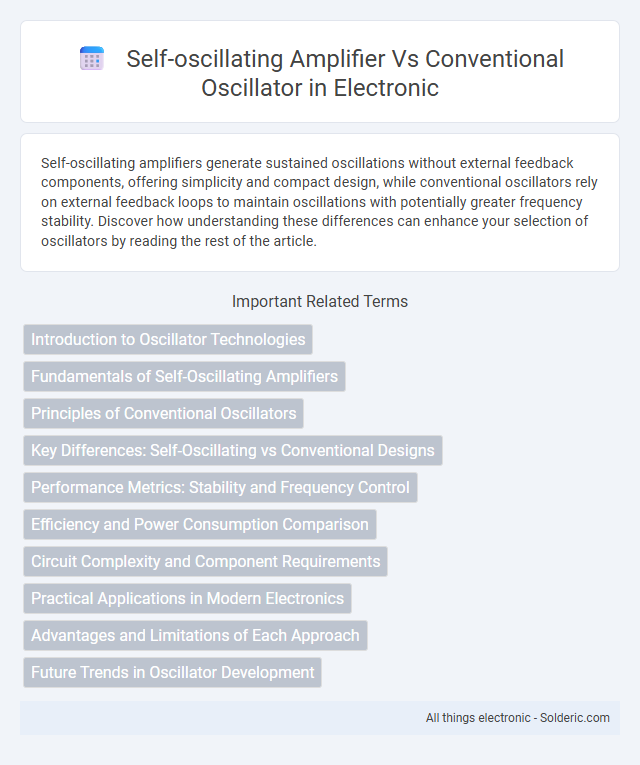Self-oscillating amplifiers generate sustained oscillations without external feedback components, offering simplicity and compact design, while conventional oscillators rely on external feedback loops to maintain oscillations with potentially greater frequency stability. Discover how understanding these differences can enhance your selection of oscillators by reading the rest of the article.
Comparison Table
| Feature | Self-Oscillating Amplifier | Conventional Oscillator |
|---|---|---|
| Operation Principle | Uses internal feedback to sustain oscillations | Relies on external feedback network to generate oscillations |
| Circuit Complexity | Simple, fewer components | Typically more complex with additional components |
| Frequency Stability | Moderate stability, sensitive to component variations | Higher stability due to precise feedback control |
| Frequency Tunability | Limited frequency tuning capability | Wide frequency tuning available |
| Power Consumption | Generally lower power consumption | May consume more power due to complex design |
| Common Applications | Simple signal generation, pulse circuits | High precision oscillators, RF circuits, clocks |
Introduction to Oscillator Technologies
Self-oscillating amplifiers generate sustained oscillations by feeding a portion of their output signal back to the input with the correct phase and amplitude, crucial for stable frequency generation in RF and audio applications. Conventional oscillators rely on external frequency-determining components such as LC or crystal resonators to control oscillation frequency, offering greater frequency stability but often with increased circuit complexity. Understanding these oscillator technologies helps you select the optimal solution for your design requirements, balancing factors like stability, signal purity, and component count.
Fundamentals of Self-Oscillating Amplifiers
Self-oscillating amplifiers generate continuous oscillations by using positive feedback, where the amplifier output is fed back in phase to the input, sustaining oscillations without an external frequency source. Unlike conventional oscillators, which often rely on discrete components like LC or crystal resonators to establish the oscillation frequency, self-oscillating amplifiers inherently combine amplification and frequency-selective feedback within the same circuit. Understanding the fundamental principle of Barkhausen's criteria--where loop gain equals one and total phase shift is zero or an integer multiple of 2p--is essential for designing your self-oscillating amplifier effectively.
Principles of Conventional Oscillators
Conventional oscillators rely on a frequency-selective feedback network that satisfies the Barkhausen criterion, ensuring the loop gain is unity and phase shift is zero or an integer multiple of 2p at the desired oscillation frequency. They typically use components such as LC tanks, RC networks, or crystal resonators to establish stable frequency determination through resonance. The consistent phase and amplitude conditions allow for sustained sinusoidal oscillations without external input signals.
Key Differences: Self-Oscillating vs Conventional Designs
Self-oscillating amplifiers generate sustained oscillations through internal positive feedback without requiring an external frequency-determining network, while conventional oscillators rely on an external resonant circuit such as LC tanks or crystal resonators for frequency stability. Self-oscillating designs tend to exhibit faster startup times but may suffer from less precise frequency control compared to the highly stable output of conventional oscillators. Key differences include circuit complexity, frequency selectivity, and amplitude stability, with conventional oscillators favored in applications demanding accurate frequency synchronization.
Performance Metrics: Stability and Frequency Control
Self-oscillating amplifiers provide enhanced frequency stability through inherent feedback mechanisms, minimizing drift under varying environmental conditions compared to conventional oscillators. Conventional oscillators rely on external components like crystal filters for frequency control, which can introduce sensitivity to temperature and aging effects. You benefit from improved long-term stability and precise frequency regulation when using self-oscillating amplifier circuits in your designs.
Efficiency and Power Consumption Comparison
Self-oscillating amplifiers typically offer higher efficiency than conventional oscillators by integrating feedback and amplification in a single loop, reducing power losses. Conventional oscillators often require separate amplifier stages, increasing power consumption and heat dissipation. Your choice between these two depends on the need for lower power usage or circuit simplicity, with self-oscillating amplifiers being more suitable for energy-sensitive applications.
Circuit Complexity and Component Requirements
Self-oscillating amplifiers typically require fewer components and simpler circuit designs compared to conventional oscillators, which often involve multiple reactive elements like inductors and capacitors for frequency determination. The reduction in circuit complexity in self-oscillating amplifiers arises from their inherent feedback mechanism that sustains oscillations without the need for external tuning components. Your choice of oscillator can impact the overall design cost and reliability, with self-oscillating amplifiers offering a more streamlined and compact solution.
Practical Applications in Modern Electronics
Self-oscillating amplifiers find prevalent use in RF signal generation and frequency synthesis due to their simplicity and stability in maintaining oscillation without external feedback components. Conventional oscillators, characterized by their reliance on external resonant circuits, dominate applications requiring precise frequency control and low phase noise, such as in communication systems and clock generation. Both types underpin critical functionalities in modern electronics, with self-oscillating amplifiers excelling in compact, integrated designs and conventional oscillators preferred for high-precision timing and signal integrity.
Advantages and Limitations of Each Approach
Self-oscillating amplifiers offer simplified circuit design with fewer components and inherent frequency stability, making them ideal for compact, low-frequency applications. Conventional oscillators provide greater frequency precision and tunability, suitable for high-frequency or complex waveform generation but often require more components and careful stabilization. Your choice depends on the specific requirements for frequency accuracy, circuit complexity, and application environment.
Future Trends in Oscillator Development
Future trends in oscillator development emphasize integrating self-oscillating amplifiers with advanced semiconductor materials such as GaN and SiC to achieve higher frequency stability and power efficiency. Conventional oscillators are increasingly being enhanced through digital control and MEMS technology for improved miniaturization and thermal stability. Your choice of oscillator will benefit from developments that offer lower phase noise and enhanced tunability, critical for 5G communications and IoT applications.
Self-oscillating amplifier vs Conventional oscillator Infographic

 solderic.com
solderic.com